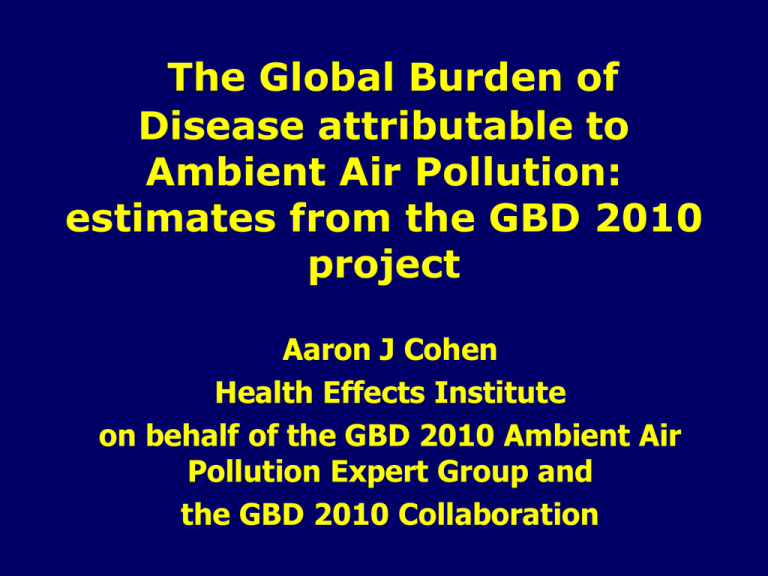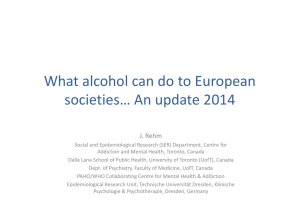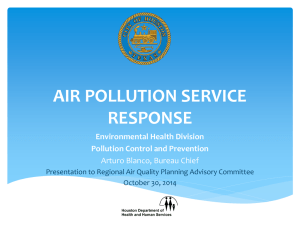
The Global Burden of
Disease attributable to
Ambient Air Pollution:
estimates from the GBD 2010
project
Aaron J Cohen
Health Effects Institute
on behalf of the GBD 2010 Ambient Air
Pollution Expert Group and
the GBD 2010 Collaboration
The Global Burden of Disease attributable to
Ambient Air Pollution: estimates from the GBD
2010 project
• What is GBD 2010?
• Drivers of global health patterns relevant to the
ambient air pollution-attributable burden
• Methods for estimating exposure and risk
• The global and regional burdens attributable to
ambient air pollution
• Conclusions and implications
Global Burden of Disease 2010
• A systematic scientific effort to quantify the
comparative magnitude of health loss for 187
countries from 1990 to 2010. Last major update
was for 2000 under the auspices of WHO
• Covering 291 diseases and injuries, 1,160
sequelae of these diseases and injuries, and 67
risk factors or clusters of risk factors
• GBD 2010 study initiated in 2007 funded by Bill
and Melinda Gates Foundation
• Summary papers published in a dedicated triple
issue of the Lancet December 15th, 2012
http://www.thelancet.com/themed/global-burden-of disease
GBD 2010 Team
488 authors from 303 institutions in 50 countries
Ambient Air Pollution Expert Group
H Ross Anderson (Co-Chair)
Markus Amann
Michelle Bell
Michael Brauer
Bert Brunekreef
Richard Burnett
Aaron Cohen (Co-Chair)
Frank Dentener
Majid Ezzati
Bryan Hubbell
Kan Haidong
Michal Krzyzanowski
Francine Laden
Stephanie London
Randall Martin
Sumi Mehta
Bart Ostro
Kiran Dev Pandey
Arden Pope
Beate Ritz
Isabelle Romieu
Amir Sapkota
Kirk Smith
George Thurston
Rita van Dingenen
Aaron van Donkelaar
SGHMS U London
IIASA/Vienna
Yale University
U British Columbia
U Utrecht
Health Canada
Health Effects Institute
EC-JRC
Harvard University
USEPA
Fudan University
WHO/Euro-Bonn
Harvard University
NIEHS
Dalhousie University
UN Fnd Clean Stoves Program
California EPA
World Bank
Brigham Young U
UCLA
IARC
U Maryland
UC Berkeley
New York University
EC –JRC
Dalhousie University
Four Key Drivers of Rapid Changes in Global
Health Patterns
1) Demographic transition – increasing population
size, substantial increase in the average age in
most regions and falling death rates.
2) Cause of death transition – fraction of deaths or
years of life lost shifting from communicable,
maternal, neonatal and nutritional to noncommunicable diseases and injuries despite the
HIV epidemic.
3) Disability transition – steady shift to burden of
disease from diseases that cause disability but
not substantial mortality.
4) Risk transition – shift from risks related to
poverty to behavioral risks.
Dramatic Demographic Shifts: Mean Age of
Death Rising Rapidly
Percent of DALYs* from Non-Communicable Diseases in 2010:
Over 60% in Nearly All Countries Outside of Sub-Saharan Africa
Disease Burden = Disability-Adjusted Life Years (DALYs) or healthy years of life
lost
GBD 2000: Mortality attributable to
leading risk factors
High blood pressure
Tobacco
High cholesterol
Underweight
Unsafe sex
Low fruit and vegetable intake
Overweight and obesity
Physical inactivity
Alcohol
Unsafe water, sanitation, and hygiene
High-mortality developing
Indoor smoke from solid fuels
Lower-mortality developing
Iron deficiency
Developed
Urban air pollution
Zinc deficiency
Vitamin A deficiency
Contaminated health care injections
Occupational airborne particulates
Occupational risk factors for injury
Lead exposure
Illicit drugs
0
Ezzati et al. 2002; WHO 2002
1000
2000
3000
4000
5000
6000
Mortality in thousands (Total 55.86 million)
7000
8000
GBD 2010: Improving estimation of
Ambient Air Pollution Burden
• Estimate exposure for populations in rural
areas and cities <100,000
• Utilize expanded evidence base on air
pollution and specific outcomes to
estimate burden
• Develop and apply new methods for
estimating exposure-response functions
11
Comparative Risk Assessment 2010:
Methods
• Calculate the proportion of deaths or disease
burden holding other independent factors
unchanged
• Counterfactual analysis: What if risk exposure
was at a different level – e.g., lower PM2.5 or
normal blood pressure or BMI?
• 67 risk factors and clusters of risk factors
• 20 age groups, both sexes, 187 countries, and
for 1990, 2005, and 2010
Estimating the Global Burden of
Disease due to Ambient Air Pollution
Worldwide
Health
Evidence
Exposure
to Outdoor
Air
Pollution
Concentration
–Response
Relationships
CountrySpecific
Mortality,
Disease
Baseline
Incidence
Global
Burden,
DALYs,
Mortality
Risk factor definition: Ambient air
pollution
• Air pollution exposures are mixtures
• Relative contribution of different pollutants a
function of location-specific
• Economic/development, social, technological
factors
• meteorology, topography, geography
(transport)
• Literature (measurements) for small number of
selected pollutants
• PM (TSP, PM10, PM2.5), O3, NOx, SO2, CO…
Air pollution metrics
PM2.5
• Most robust indicator in epidemiologic studies
• Biological plausibility supported by toxicology,
dosimetry, studies of acute exposures, controlled
exposures
• General indicator of combustion source air
pollution
• Also incorporates respirable fraction of crustal PM
(“dust”)
• Evidence does not support differential risk based
on PM2.5 mixture composition
Air pollution metrics
Ozone
• Represents somewhat distinct mixture from PM
(photochemical oxidation) with different
seasonal, spatial and temporal patterns
• Epidemiologic associations (independent from
PM) with premature mortality
• Extensive literature of adverse respiratory
impacts in controlled exposures
16
PM ground-level measurements (2005)
•
•
•
Measurements:
North America,
Europe, Australasia
Estimates (from
PM10): Asia, Latin
America
No info: 7 / 21 GBD
region
• Global estimates
of PM2.5 at 10km
x 10km scale
• Combined
estimates from
satellites (AOD),
chemical
transport
models and
ground-level
measurements
• Estimates
include
contribution of
all sources of
PM2.5
• 1.4 million grid cells in total
• Linked to global gridded population (including urban-rural indicators)
• Allows for country-level burden estimation
Estimated 2010 levels of PM2.5 in China
Estimated population-weighted ambient air pollution
levels - PM2.5 -increased worldwide and in China 19902010
1990 → 2010:
10% increase in global
population-weighted PM2.5
50% increase in populationweighted PM2.5
Household solid fuel emissions also contribute
to Ambient Air Pollution
• Global: household emissions contribute ~15% (4 µg/m3)
of PM2.5
• China: household emissions contribute ~ 15% of ambient
PM2.5– about 7µg/m3
Estimated 2005 seasonal (3 month)
hourly maximum ozone concentrations
(ppb)
TM5 model
GBD 2010 estimates based on systematic review of
worldwide evidence on health effects of air pollution
• Evidence on adverse health effects of ambient air pollution
comprises thousand of peer-reviewed studies, including over 400
epidemiologic studies in China and other parts of Asia since 1980
(HEI Special Report 18 2010)
• Causes of mortality included in GBD estimates for Ambient Air
Pollution Exposure were chosen based on systematic reviews of
the evidence for:
• Ischemic Heart Disease and Cerebrovascular Disease (US EPA 2009; American
Heart Association 2011; WHO 2006; Burnett et al. 2013 in preparation)
• Chronic Obstructive Pulmonary Disease (Schikowski T et al. 2013 In Press)
• Lung Cancer ( Samet and Cohen 2006; IARC Monographs 92, 105, et al.)
• Acute Lower Respiratory Tract Infection <5 yrs (Mehta S et al. 2011)
• Pre-term Birth and Term Low Birth weight (Sapkota A et al. 2011)
• Asthma (Anderson HR et al. 2009; 2011)
Diseases affected by air pollution are the top 5 causes of the
global burden of disease in 2010
(Lozano R et al. 2012)
A model for estimating the global attributable
burden: Integrated exposure-response function
(IER)
•
All cohort studies of PM2.5 and
mortality from chronic disease have
been conducted in the US and Western
Europe
•
New models needed to estimate
exposure-response functions at high
levels of PM in Asia, other regions
•
IERs estimate E-R functions using
results of studies of second-hand
smoke (SHS) , household air pollution
(HAP), and active tobacco smoking
(ATS) (Burnett R et al. 2013
Submitted)
•
Key model assumptions:
• Risk is a function of PM2.5 inhaled
dose regardless of source (Pope et
al. 2009; 2011)
• Consistent with risk observed in
current cohort studies
• Predict risk for highest PM2.5
concentrations consistent with
risks from SHS, HAP, active
smoking
From: Pope CA et al. EHP 2011
Exposure-response function estimation
•
•
•
•
•
Compiled study‐level estimates of the RR of mortality associated with any
or all of ambient air pollution, second‐hand smoke (SHS), household air
pollution (HAP), and active smoking (AS) for the following causes:
ischemic heart disease (IHD), stroke, lung cancer, chronic obstructive
pulmonary disease (COPD), and acute lower respiratory infection (ALRI) in
children
Convert SHS, HAP, and AS to equivalent PM2.5 ambient 24 hour exposure.
Observed relationship between PM2.5 and CV RR suggested function must
be able increase sharply for low concentrations and plateau at very high
cigs/day levels (>25~17,000 µg/m3).
An exponential decay model with a power of concentration – the
Integrated Exposure Response function (IER) – is one function that has
these properties.
Model implicitly assumes that RR in ambient range cannot be greater than
that for source with highest PM2.5 concentration
•
•
•
AS for mortality
HAPs for ALRI
Evaluated a range of non‐linear functions with up to three parameters for
fitting the integrated exposure‐response (IER) relationship and evaluated
goodness-of-fit using the Bayesian Information Criterion – IER was the
functional form that provided the best overall fit
Ambient Air Pollution Cohort Mortality Studies Used to
Estimate Integrated Exposure-Response Functions
Integrated Exposure-Response Function for IHD
7 µg/m3
29
Burnett RT, et al. 2013 Submitted
GBD risk functions predict risks from recent Chinese cohort study
Burnett et al.
2013 Submitted
Quantifying Uncertainty
• Multiple sources of uncertainty for both the risk
function and estimated attributable burden of
disease quantified and expressed as uncertainty
intervals
•
•
•
•
Uncertainty in the estimated risk function parameters
Uncertainty in the estimate of PM2.5
Uncertainty in the counterfactual concentration
Uncertainty in the estimated baseline mortality rates
• Sensitivity analyses
• Uncertainty due to model form explored via sensitivity
analysis comparing different model forms
• The influence of wind-blown dust on the burden
estimates will be addressed by an analysis in which the
counterfactual is increased in dusty regions
Burden of disease attributable to risk factors
in the world in 1990
Burden of disease attributable to risk factors
in the world in 2010
Risk Factors for global deaths and
DALYs in 2010
3.2 million
deaths and
76 million
DALYs
Risk factor ranks in 2010 by GBD region
Leading risk factor by country in 2010
Top 20 Mortality Risk Factors
in the US, India, and China in 2010
Ambient PM2.5
caused an
estimated
1,234,000
deaths; 14.9%
of all deaths in
2010
Deaths Attributable to Ambient PM2.5 by
Cause in the US, India, and China in 2010
Deaths Attributable to Ambient Particulate Matter Pollution in 2010
US
India
China
Total attributable deaths
= 103027
Total attributable deaths =
627426
Total attributable deaths =
1233891
DALYs Attributable to Ambient PM2.5 by
Cause in the US, India, and China in 2010
DALYs Attributable to Ambient Particulate Matter Pollution in 2010
US
India
China
Total attributable
DALYs= 1820412
Total attributable
DALYs= 17759991
Total attributable DALYs=
25227281
Ozone and Mortality from COPD in 2010
Deaths Attributable to Ozone 2010
Sub-Saharan Africa, West
Sub-Saharan Africa, Southern
Sub-Saharan Africa, East
152,000 (52K, 267K) COPD
deaths in 2010
Sub-Saharan Africa, Central
Oceania
North America, High Income
North Africa / Middle East
Latin America, Tropical
Latin America, Southern
Latin America, Central
Latin America, Andean
Europe, Western
Europe, Eastern
Europe, Central
Caribbean
Australasia
Asia, Southeast
Asia, South
Asia, East
Asia, Central
Asia Pacific, High Income
0
10
20
30
40
50
60
Number
of Deaths
in Thousands
70
80
90
100
Some conclusions and implications of the GBD
2010 estimates
• Ambient air pollution now ranks among the top 10 global risk
factors for lost years of healthy life
• Attributable deaths and DALYs much larger than previously
estimated: 3.2 million deaths and 76 million DALYs in 2010
due in large part to mortality from IHD and stroke
GBD 2010 estimates larger than estimated for 2000 :
Urban and rural populations included
• Larger risk coefficients
• Increases in PM2.5 levels in some regions , e.g. East and
South Asia
• Increased rates of IHD, stroke in developing Asia and
elsewhere
Some conclusions and implications of the GBD 2010
estimates
Developing Asia contributes over 2/3 of the air pollutionattributable burden of disease due to regional increases in both
pollution levels and rising rates of cardiovascular disease:
stroke and ischemic heart disease: 4th and 7th leading risk factor
in East and South Asia, respectively
The burden of disease attributable to ambient air pollution in
East and South Asia has increased from 1990 to 2010 due in
large part to increased PM2.5 levels and increased rates of death
from stroke and heart disease
Air pollution is an increasingly important cause of lung cancer in
developing Asia contributing to 20% of lung cancer in China in
2010
Ambient air pollution contributes to the decreasing but still
large burden of childhood ALRI in Asia
Some conclusions and implications of the GBD 2010
estimates
The combined public health impact of air pollution, ambient
and household, is substantial, and developing Asia
experiences some of the highest levels of exposure and the
largest burdens of disease from both risk factors in the
world
• Given widespread exposures, interventions can be very
(cost) effective
• It will require substantial improvements in air quality to
achieve the largest benefits from air pollution reduction in
very polluted settings
43
Thank You !
Aaron Cohen
acohen@healtheffects.org
for more information on the GBD
Collaboration
http://www.healthmetricsandevaluation.org/gbd









